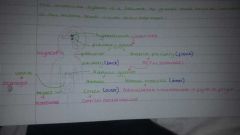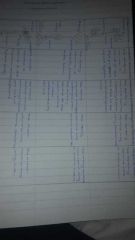![]()
![]()
![]()
Use LEFT and RIGHT arrow keys to navigate between flashcards;
Use UP and DOWN arrow keys to flip the card;
H to show hint;
A reads text to speech;
45 Cards in this Set
- Front
- Back
|
Who was the founder of psychology? |
Wilhelm wundt |
|
|
What is his approach known as? |
Structuralism,study of the structure of the human mind |
|
|
Where did he work? |
Leipzig in germany |
|
|
What was introspection? |
The first systematic exlerimental attempt to study the mind by breaking conscious awearness uo into basic structures of thoughts images and sensations |
|
|
What did Griffiths Do? |
Investigated the thought processes of gamblers on fruit machines. He found that they used more irrational thought processes |
|
|
What is introspection? |
Where you ask participants to consider and reflect on their cognitive process and describe them |
|
|
What's wrong with Wundt's approach? |
His research is low in reliability as when other people replicated it they got different results It is also not accurate as participants have little knowledge of the causes of underlying pit attitudes and behaviours |
|
|
What did he believe? |
The human mind could be scientifically studied using natural sciences and experiments |
|
|
Who rejected introspection and Why? |
John b(1913) said it was subjective as it couldnt be observed or measured |
|
|
Parts of CNS |
Brain- ceretal cortex highly developed, center of all conscience Spinal cord-involved in reflex actions |
|
|
Autonomic nervous system breakdown |
Sympathetic nervous system- prepares you for stressful situations Parasympathetic nervous system-relaxes you |
|
|
What is meant by genotype and phenotype? |
Genotype is you genetic coding and phenotype is how this is expressed in the environment |
|
|
PNS |
Peripheral nervous system transmits messages via neurons to and from CNS |
|
|
Nervous system |

|
|
|
CNS |
Central nervous system Passes messages to&from brain and connects nerves to pns |
|
|
The twins experiment |
Gottesman and shields found that the concordance rate in twins was 42% in monozygotic twins and 9% in dizygotic twins |
|
|
part of PNS |
Autonomic Nervous system- controls breathing heart beat&stress respons Somatic nervous system- carries sensory info to and from spine |
|
|
Endocrine system |

|
|
|
What happens to left over neurotransmitters? |
They are broken down by enzymes They get taken back up via reuptake |
|
|
What is action potential? |
An explosion of electrical activity that activates a resting neurons |
|
|
What does excitatory mean? |
Make it more likely the next neurons will fire |
|
|
Description of the neurons |

|
|
|
What are neurotransmitters released in? |
synaptic vesicles into the synapse |
|
|
Evaluate the biological approach |
☆it can be applied to real world ☆ produces replicated data
●explanations are too simplistic |
|
|
What is the endocrine system? |
Network of glands that secrete hormones in the blood that travel to the needed cells |
|
|
Which berhaviousirst acientis dominated psychology in the 1930's? |
B.F Skinner as he bought natural sciences into psychology |
|
|
What did the cognitive revolution in 1960 bring about? |
It being seen as legitimate as scientists can make inferences on cognitions via tests in labs |
|
|
What was introduces in the 1990's |
The biological approach as technology got better so brain scans and EEG could be done |
|
|
What are standardised procedures? |
When everything is the same so thr samr instructions are carried out in the same way so that they can be replicated |
|
|
F |
G |
|
|
What does inhibition mean? |
Make is less likely the next neurons will fire |
|
|
What is classical conditioning? |
Leaning by association |
|
|
Who came up with classical conditioning? |
Pavlov by conditioning dogs to salivate when a bell rings |
|
|
Explain calssical conditioning |
UCS->UCR NS-> no response NS+UCS->UCR US->UR |
|
|
What is operant conditiong? |
Learning by consequence |
|
|
Who came up with oprant conditioning? |
Skinner by using ratels and pigeons in desinged cages |
|
|
What are the three types of reinforcement? |
Positive- rewarded with something pleasant Negative- something unpleasant is removed Punishment- an unpleasant consequesnce |
|
|
What are the strengths of behaviourism? |
Experiments were done in lab controlled conditions so its replicable Brought in natural sciences making it more credible |
|
|
What are the limitations of behaviourism? |
Has ethical issues as animals are used-low validity due to stressful livelyhood in cages A form of environmental determinism as ignores free will |
|
|
What are the four stanges of SLT? |
Attraction (bahaviour noticed) Retention (behaviour is remembered) Motor reproduction (being able to do it) Motivation (will perform behaviour) |
|
|
What did Bandura do? |
Bobo doll experminat 1 --- some children watching adults show afression towards doll and some playinf nicely 2 --- all adults showed agression some were rewarded some were punished and some nothing happenes |
|
|
What are the strengths of SLT? |
Emphasises the importance of cognitive factors as no behavioural ones were used Accounts for cultural differences Acknowledges free will as are only influenced by environment |
|
|
What are the limitations of SLT? |
Low external validity as demand characteristics could of happened Boys higher level of agression than girls so could br to do with genes and testosterone |
|
|
How are cognitions observed? |
By making inferences about what is going on in peoples head |
|
|
H |
H |

